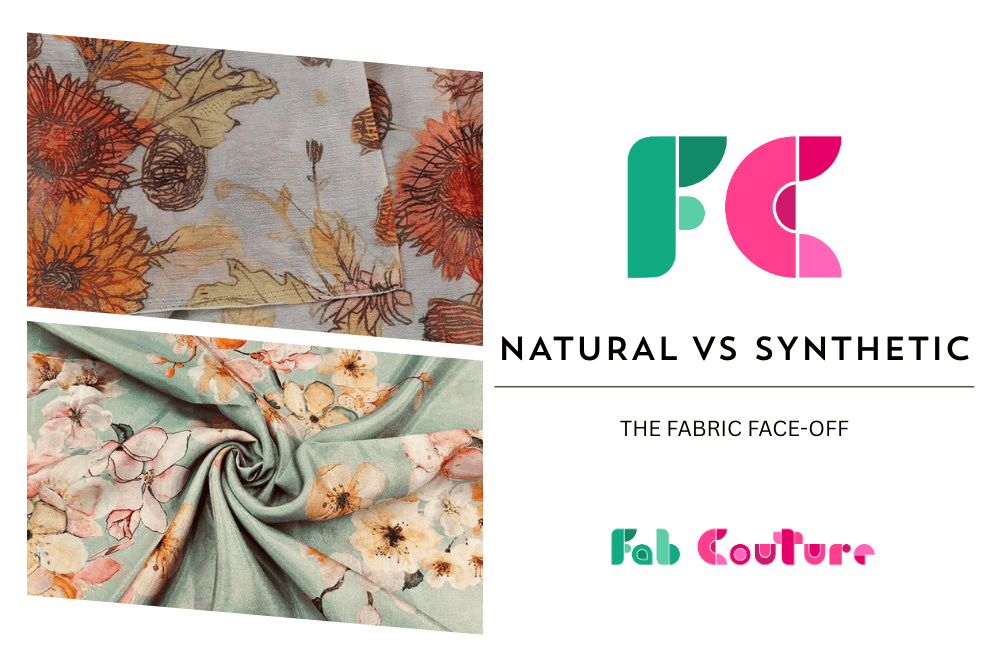- Home
- Blogs
- FabCouture
- Natural vs. Synthetic Fabrics – Which Works Best for Indian Weather?
- Natural vs. ...
Natural vs. Synthetic Fabrics – Which Works Best for Indian Weather?
- By Fabcouture
- • Sep 12, 2025

India’s diverse climate, ranging from scorching summers to humid monsoons and chilly winters, makes fabric selection more than just a style choice—it’s about comfort, durability, and practicality. Choosing between natural and synthetic fabrics can be tricky, especially when you’re considering how they perform in Indian weather conditions. Let’s explore both, their pros and cons, and which works best depending on the season and occasion.
The right fabric can make or break your outfit in India’s weather. A breezy kurta in cotton can feel like a savior in peak summer, while a polyester blouse may leave you sweating uncomfortably. Similarly, while chiffon or georgette sarees bring elegance to festive evenings, they may not provide enough warmth during a chilly north Indian winter wedding. Fabrics not only influence style but also directly impact how you feel throughout the day—choosing wisely ensures comfort, longevity of your garment, and a look that fits the occasion as well as the season.
Natural Fabrics – Comfort Rooted in Nature
Natural fabrics such as cotton, linen, silk, and wool are derived from plants and animals. They are highly valued in Indian fashion for their breathable texture, softness, and timeless appeal.
- Cotton Fabrics: A staple for Indian summers, cotton absorbs sweat and allows the skin to breathe, making it ideal for hot and humid weather. Kurtas, sarees, shirts, and everyday wear made of cotton are practical choices.
.jpg)
- Linen Fabrics: Known for their crisp texture, linen fabrics are excellent in high heat because of their superior breathability.
- Silk Fabrics: While not as breathable, silk adds elegance and drapes beautifully, making it a go-to for weddings and festive wear in cooler months.
- Wool Fabrics: Suitable only for the northern winters of India, wool provides insulation and comfort when the temperature dips.
Pros of Natural Fabrics:
- Breathable and skin-friendly
- Biodegradable and eco-friendly
- Absorbs moisture, making it ideal for hot climates
Cons of Natural Fabrics:
- May wrinkle easily (linen, cotton)
- Higher maintenance (silk, wool)
- Often more expensive than synthetics
Synthetic Fabrics – Modern Convenience
Synthetic fabrics like polyester, rayon, georgette, and chiffon are man-made, often blended with natural fibers to enhance durability and reduce cost. They are widely used in modern Indian fashion because of their versatility and affordability.
- Polyester & Rayon: Wrinkle-resistant, quick-drying, and durable, but can feel uncomfortable in extreme heat.
- Chiffon Fabrics: Lightweight and sheer, chiffon fabric is excellent for flowy sarees, gowns, and festive outfits, especially in mild weather.
- Georgette Fabrics: Similar to chiffon but with more structure, georgette fabric works well for stylish suits, lehengas, and Indo-western outfits.
.jpg)
Pros of Synthetic Fabrics:
- Easy to wash and maintain
- Affordable and long-lasting
- Wide range of textures and finishes available
Cons of Synthetic Fabrics:
- Less breathable, may trap heat in summers
- Not as skin-friendly as natural fabrics
- Environmental impact due to non-biodegradable fibers
Which Fabrics Work Best for Indian Weather?
- For Summers & Humid Weather: Stick to natural fabrics like cotton and linen to stay cool and comfortable. Light georgette or chiffon can also work for evening occasions when temperatures drop.
- For Monsoons: Quick-drying synthetics such as polyester blends are practical, though natural fabrics in darker shades can also be worn.
- For Winters: Natural fabrics like wool and silk provide warmth and elegance. Synthetic blends can add layering without bulk.
- For Weddings & Festivals: A mix works best—silk, georgette, and chiffon fabrics bring richness, while cotton and linen are perfect for casual pre-functions and day events.
Final Takeaway
When choosing between natural and synthetic fabrics for Indian weather, the key lies in balance. Natural fabrics are unbeatable for comfort in the heat, while synthetics offer convenience and versatility for special occasions. By mixing both smartly, you can enjoy the best of style and practicality throughout the year.
Leave a Comment
Blogs
Popular Posts
Newletter
Thanks for subscribe.

Fabcouture is an online fabric store to satisfy all your couture fabrics cravings for fabric connoisseurs. We delight in the fact that we source...
0 Comment